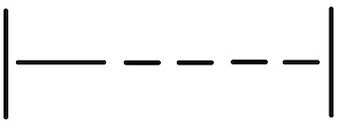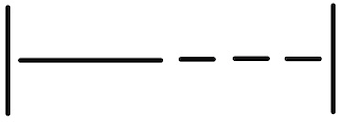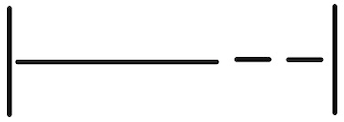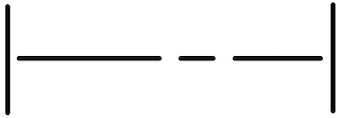Compound Meter: Further Divisions
Compound beats typically divide into three parts/divisions. Those three divisions, in turn, are each typically represented by an un-dotted note such as an eighth note, which means they typically further divide (“subdivide”) into twos. This gives a total of six possible subdivisions within each beat.
There is a huge number of ways those six subdivisions might be articulated. As you work with compound meter and figure out which of this huge number of possibilities is happening at any given time, it may be helpful to bring to bear your subdivision skills to keep track of the beat division physically as you listen or perform. For example, you could tap three fingers in succession for each beat: these three fingers will help you track whether each note happens at the “beginning,” “middle,” or “end” of the compound beat—or in between two of these. Eventually, however, we will strive to learn at least the most common rhythms as units that do not need to be subdivided to be recognized.
For now, here are a few relatively common possibilities that are worth memorizing. Any of the notes in the cells below may be replaced by rests. When this occurs, we simply need to experience the rest as a (silent) part of the pattern.
Students often confuse cells C8 and C9. If you have trouble with this, note that the short notes in C8 often seem to lead smoothly into the beginning of the next beat, while C9 briefly comes to a longer note at the “end” of the compound beat.
| Reference number: | C6 | C7 | C8 | C9 | C10 |
|---|---|---|---|---|---|
| Description: | long-four shorts | long-three shorts | long-two shorts | long-short-medium | medium-long-short |
| Staff notation (dotted eighth note beat): | |||||
| Staff notation (dotted quarter note beat): | |||||
| Staff notation (dotted half note beat): | |||||
| Takadimi syllables: | ta ki di da ma | ta di da ma | ta da ma | ta di da | ta ki ma |
| Number syllables: | 1 la ta li ta | 1 ta li ta | 1 li ta | 1 ta li | 1 la ta |
| Kodaly syllables: | |||||
| Protonotation |  |
 |
 |
 |
 |
Activity: Improvise and identify rhythms
Goal: Generate or identify rhythmic cells.
Before you start: This activity works best with at least one other person. But you can also do it on your own; just skip step 3.
Instructions:
- Identify one person to improvise.
- The improviser comes up with and performs a short rhythm (perhaps 4–6 beats long) made up entirely of the rhythmic cells defined above, plus optionally notes longer than a beat.
- The other student(s) identifies/identify which cells were used and in what order.
If this activity feels too easy, go ahead and add pitches at an appropriate difficulty level to the improvised rhythm.
Activity: Read rhythmic cells
Goal: Notice when rhythmic cells occur in notated music.
Before you start: You’ll need a source of notated melodies or rhythms that primarily use the rhythmic cells listed above. Sight-reading anthologies are a good source. You can do this activity vocally or on another instrument.
Instructions:
- Look over the notation, note the meter, and set up an appropriate sense of meter internally.
- Scan over the notation, identifying rhythmic cells. Note that some notes in the rhythmic cells may be replaced by rests; you can still call up the “sense” of the rhythmic cell, simply experiencing the silence as part of the pattern.
- Perform the rhythm, with or without pitch.
Activity: Find rhythmic cells “in the wild”
Goal: Develop sensitivity to rhythmic patterns as they occur in music.
Instructions:
Note: using “Compound” mode in Brian Edward Jarvis’s Rhythmic Pattern Dictation Trainer is a useful preparatory exercise or substitute when feedback is needed but no one is around to give it.
- Listen to a song from the playlist below and determine its meter.
- Listen to the first 1–2 phrases of the song and identify the rhythmic cells used and their order.
- Optionally, identify an appropriate meter, time signature, and durational symbols that represent the music.
Activity: “Point and Perform” in a Group
Goal: Perform indicated rhythmic cells
Before you start: This is a group activity.
Instructions:
- Identify a leader. This person will display the defined rhythmic cells in a way that everyone else can see, such as in notation or protonotation on a board.
- The leader sets up a steady beat, perhaps by conducting, and everyone else aligns themselves with that beat.
- Once everyone is ready, the leader points at rhythmic cells, and the other participants perform them on rhythmic solfège, on “ta,” or by clapping or tapping. The leader should start by changing slowly, allowing the other participants to settle into each cell by performing it a few times in a row; as people get more comfortable, the pace of change can speed up until you are changing every beat.
Activity: Improvise rhythmic cells while listening to music
Goal: Use defined rhythmic cells to improvise to a piece of music.
Instructions:
- Start one of the songs in the playlist below.
- Pick a rhythmic cell listed above and perform it to the beat of the song playing
- As you perform the rhythmic cell, listen for where significant changes seem to happen in the music. At these points, change to a new rhythmic cell! If you feel like you aren’t able to hear these points of change while performing the rhythm, that’s ok (we’ll work on listening for form later)—just change when it feels appropriate to you.
- Continue to switch patterns until you feel comfortable with each of the four cells.
- If you feel pretty comfortable with the rhythmic cells, you might start performing them one after another or even jumping between them randomly instead of repeating one over and over.
Image Attributions |
|

